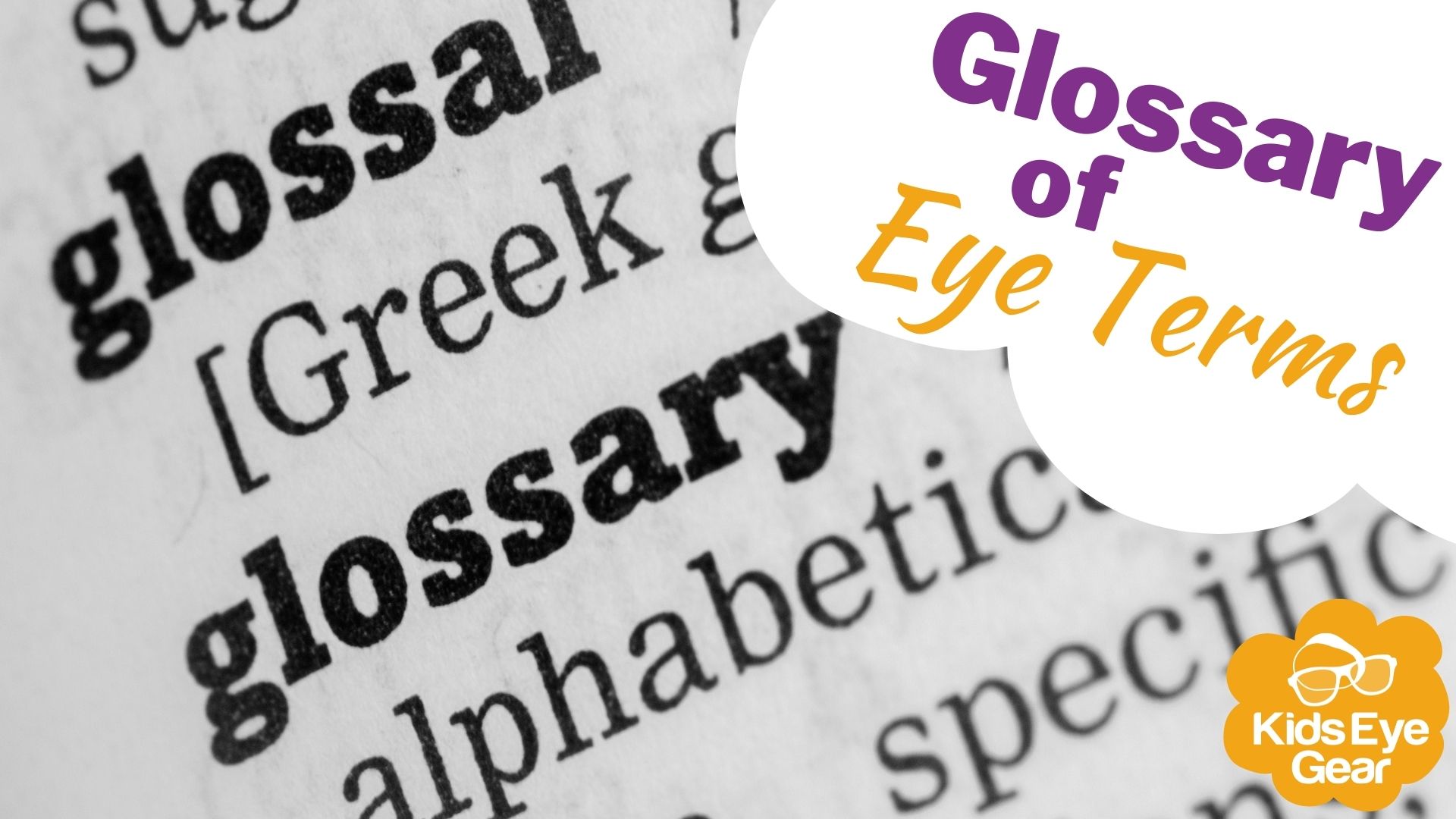Glossary of Eye and Vision Terms
5th Sep 2021

Introducing the Kids Eye Gear Glossary of Eye Terms
Your eye care journey could take you into many offices with many different doctors and specialists and there will be a lot of medical jargon thrown around. A lot of the time you are going to be left confused and left thinking, "But what does that even mean?"
If you have found yourself going "Hey Siri, what does anisocoria mean?" right after an eye appointment, we have the perfect list of eye conditions and terms for you.
A to D
Achromatopsia – An inherited condition where you lack certain receptors in your retinas, leading to colour blindness and dull vision.
Amblyopia – A condition, (often developed from childhood), known as lazy eye, where one eye is stronger, so the weaker eye is ignored by the brain. Patching therapy is used to treat Amblyopia. With BCC (see below), amblyopia can be in both eyes.
Anisocoria - A condition characterized by an unequal size of the eyes' pupils.
Aphakia – When you have no lens in your eye, due to surgery or congenitally.
Aqueous Humor – The clear fluid between your cornea and lens.
Astigmatism – A condition where the cornea is oval instead of round. It causes blurry vision, and can be treated with glasses, contact lenses or surgery.
BCC - Bilateral congenital cataracts Bilateral - two or both sides Congenital - from birth
Bilateral – Both eyes.
Cataract – A clouding of the lens of the eye, causing loss of vision.
Choroid – The layer of blood vessels between your retina and sclera.
Choroiditis – An inflammation of the eye’s middle layer.
Conjuctiva – A thin layer of tissue that lines the inside of your eyelids. When this are becomes inflamed you develop conjunctivitis, also know as pink eye.
Contact lenses – Artificial lenses that are placed on the sclera (see below), of the eye.
Cornea – The clear outer layer of your eye.
Dilation – When medicated eye drops are used to open your pupils. This is painless but can cause blurred vision for several hours afterwards.
E to I
Elschnig's Pearls - Transparent clusters formed by proliferation of epithelial lens cells. Can occur after cataract surgery. Resemble soap bubbles in the eye. They rarely affect vision.
Estropia – A condition where both eyes turn inward, also known as crossed eyes.
EUA - Examine under anaesthesia.
Hyperopia – When objects up close are blurry but things far away are clear. This is also known as farsightedness.
Intraocular – Inside the eye.
IOL - Intraocular lens.
IOP - Intraocular pressure.
Iris – The coloured part of your eye.
L to O
Lateral – Toward the ear, away from the middle of the body.
Legal blindness – When vision in both eyes cannot be corrected to better than 20/200 vision. Also known as tunnel vision.
LO - Little one. This is often used in articles regarding children.
Macula – The centre portion of your retina, which when healthy, gives you clear, sharp vision.
Myopia – When objects far away are blurry but things up close are clear. This is also known as near-sightedness.
Nystagmus – A condition of involuntary eye movement, which can increase when tired of trying to focus the eyes. Can be vertical, horizontal or rotary. This affects vision, but can be helped with glasses, contact lenses and some brain-eye training.
Ocular – When something is related to the eye.
Ophthalmologist – Doctors who specialise in medical and surgical care of the eyes. They can care for all aspects of the eye from eye exams to eye surgery and manage eye diseases and conditions.
Optic Nerve – The nerve which carries signals from your retina, to your brain.
Optometrist – A doctor who can examine, diagnose, treat and manage eye diseases and disorders. They can prescribe glasses and contact lenses. This may be your first point of contact in your eye journey.
P to R
Peripheral Vision – What you can see around your direct line of vision.
Phakic - Someone with a lens in their eye.
PHPV - Persistent Hyperplastic Primary Vitreous, also known as Persistent Fetal Vasculature (PFV), is a rare congenital developmental anomaly of the eye.
PO - Paediatric ophthalmologist, an eye doctor that works primarily with children’s eye conditions.
Pseudophakia - Someone with an IOL (see above).
Pupil – The dark opening in your eye, which lets light into your eye.
Refractive Error – When your eye does not bed light the way it should. Refractive errors are astigmatism, farsightedness and near-sightedness.
Retina – The thin layer of nerves that line to back of the eye. Incoming light creates images here that your brain reads through your optic nerve.
Retinoblastoma – A malignant tumour that forms on the retina. It can be unilateral or bilateral and often affects children under the age of 5.
RGP Lens - Rigid Gas Permeable lens. Hard contact lenses made of silicon that allow oxygen to permeate.
S to V
Sclera – The outer layer of the eye that is the whites of the eyes.
Secondary cataracts - The residue of scar tissue on the lens capsule
Strabismus - Eye turn of either one or both eyes, which can be intermittent or constant, and can be to any direction. Not to be confused with lazy eye. Crossed eyes is a type of strabismus.
Unilateral - One side only.
Visual Acuity – How well you measure on an eye chart.
Visual Field – Your range of sight.
Feeling up to date on your eye health lingo?
Great! Now you can go into your many appointments with a cheat sheet to help you feel not so out of place. You may want to check out our blog on Questions to Ask at Your Ophthalmology Appointment, while you are here.
For a PDF version of the Glossary just CLICK HERE.

